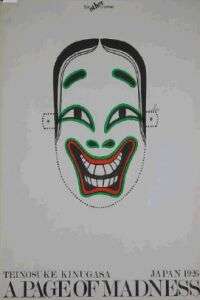A Page of Madness
| A Page of Madness | |
|---|---|
 Movie Poster | |
| Directed by | Teinosuke Kinugasa |
| Written by |
Teinosuke Kinugasa Yasunari Kawabata Banko Sawada Minoru Inuzuka |
| Starring |
Masao Inoue Ayako Iijima Yoshie Nakagawa Hiroshi Nemoto Misao Seki Minoru Takase Eiko Minami |
Release dates |
|
Running time | 60 min. |
| Country | Japan |
| Language |
Silent film Japanese titles |
A Page of Madness (狂った一頁 Kurutta Ippēji or Kurutta Ichipeiji) is a silent film by Japanese film director Teinosuke Kinugasa, made in 1926. It was lost for forty-five years until being rediscovered by Kinugasa in his storehouse in 1971.[1]:42 The film is the product of an avant-garde group of artists in Japan known as the Shinkankakuha (or School of New Perceptions) who tried to overcome naturalistic representation.[1]:12[2]:59
Yasunari Kawabata, who would win the Nobel Prize for Literature in 1968, was credited on the film with the original story. He is often cited as the film's screenwriter, and a version of the scenario is printed in his complete works, but the scenario is now considered a collaboration between Kawabata, Kinugasa, Banko Sawada, and Minoru Inuzuka.[1]:26–33 Eiji Tsuburaya is credited as an assistant cameraman.
Plot

The film takes place in an asylum, in the countryside. Although cut together in an ever maddening maelstrom, the film loosely tells the story of the janitor of the asylum. His wife is one of the patients, whom he tries to see using the set of keys to the gate. One day, their daughter arrives at the asylum to tell her parents about her plans for the wedding date. This sets off a number of subplots and flashbacks which stitch together the family history.
Outside while talking to the guard's young son, she discovers the truth that her father is working as a janitor in the asylum. The daughter had only been aware that he was only living in the asylum to be close to her mother, but unaware in the nature of his job. While alone with him, she confronts her father for not telling her the truth of his job. This prompts him to confess that he will be the only one to attend her wedding and won't bring her mother. The janitor reveals that doesn't want his daughter to see the degenerative state of her mother's mindset.
One night, the janitor attempts to get his wife out of the asylum to attend their daughter's wedding. While fighting through the patients and doctors trying to stop him, the truth of why she's a patient at the asylum is revealed. One year ago, the wife suffered a mental breakdown and assaulted her daughter's fiancé in a form of disapproval. She demanded her to come back and the janitor had to restrain his wife. This led to him admitting her to a mental asylum. After the doctor is killed, the janitor eventually comes back to his senses. As he leaves, the janitor accidentally drops his set of keys to the gate, which one of the doctors picks up from the ground.
The next day, the janitor gives out masks to his wife and the other patients. He returns to work mopping the floors and when he finally decides to visit his wife again in her cell, he realizes that the doctors have taken the keys he dropped on the ground and the gate is locked to prevent another situation again. As the janitor leaves to resume working, he realizes things are better off this way and that his wife needs to be away from him.
Production
The film does not contain intertitles, making it difficult to follow. The print existing today is missing nearly a third of what was shown in theaters in 1926. Showings in 1920s Japan would have included live narration by a storyteller or benshi (弁士) as well as musical accompaniment. The famous benshi Musei Tokugawa narrated the film at the Musashinokan theater in Shinjuku in Tokyo.[1]:45
Cast
- Masao Inoue as the custodian
- Ayako Iijima as the custodian's daughter
- Yoshie Nakagawa as the custodian's wife
- Hiroshi Nemoto as the fiancé
- Misao Seki as the chief doctor
- Minoru Takase as patient A
- Eiko Minami as the dancer
- Kyosuke Takamatsu as patient B
- Tetsu Tsuboi as patient C
- Shintarō Takiguchi as the gateman's son
Notes
- 1 2 3 4 Gerow, Aaron (2008). A Page of Madness: Cinema and Modernity in 1920s Japan. Center for Japanese Studies, University of Michigan. ISBN 978-1-929280-51-3.
- ↑ Gardner, William O. (Spring 2004). "New Perceptions: Kinugasa Teinosuke's Films and Japanese Modernism". Cinema Journal. 43 (3): 59–78. doi:10.1353/cj.2004.0017.
See also
References
- Gardner, William O. (Spring 2004). "New Perceptions: Kinugasa Teinosuke's Films and Japanese Modernism". Cinema Journal. 43 (3): 59–78. doi:10.1353/cj.2004.0017.
- Gerow, Aaron (2008). A Page of Madness: Cinema and Modernity in 1920s Japan. Center for Japanese Studies, University of Michigan. ISBN 978-1-929280-51-3.
- Lewinsky, Mariann (1997). Eine Verrückte Seite: Stummfilm und filmische Avantgarde in Japan. Chronos. ISBN 3-905312-28-X.
External links
- BBC review feature
- Sharp, Jasper (2002-03-07). "A Page of Madness". www.midnighteye.com. Retrieved 2007-04-17.
- A Page of Madness at the Internet Movie Database
- A Page of Madness at SilentEra
- A Page of Madness at AllMovie